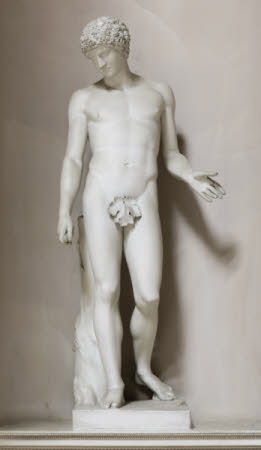The Capitoline Antinous
workshop of Matthew Brettingham the Younger (1725 - 1803)
Category
Art / Sculpture
Date
circa 1758
Materials
Painted plaster
Measurements
1770 x 780 mm
Place of origin
London
Order this imageCollection
Kedleston Hall, Derbyshire
NT 109013
Summary
Painted plaster, the Capitoline Antinous, possibly cast by Bartolomeo Mattevali on behalf of Matthew Brettingham (1724-1803), cast c. 1758. A full-length plaster cast painted white of the Capitoline 'Antinous', a Roman marble (c. 130-150 AD) after a lost Greek statue in the Musei Capitolini, Rome. A young male, nude, in contrapposto, leaning on proper right leg with left leg slightly outstretched behind and head looking down to proper right. The arms hang softly by the sides, the proper left arm bent and hand outstretched, with palm upturned and index finger pointed in a rhetorical gesture. Mounted on a painted plaster base. The statue is cast after a Roman marble in Capitoline Museum, Rome. It was first recorded in the collection inventory of Alessandro Albani, apparently having been found at Hadrian's Villa. It was one of many Albani statues purchased in 1733 by Pope Clement XII for display in the newly established Capitoline Museum (see Haskell and Penny 1981, pp. 143-4, no. 5, fig. 74).
Full description
Nathaniel Curzon (1726-1804) acquired this cast of the Capitoline Antinous from Matthew Brettingham (1725-1803), an architect who primarily dealt in antiquities and casts for the British aristocracy. The cast is recorded as 'Antinous' in a handwritten inventory of sculpture and statuary produced by Curzon himself in around 1760 (MS, Kedleston Archive). It is recorded again in a list inscribed on the verso of that inventory, under the subheading 'Hall Statues'. Although Curzon appears to have intended to display the Antinous in the Marble Hall, it was in fact installed in the Saloon until around 1788-89 when the room was remodeled into a ballroom. The cast was then moved to the Marble Hall where it stands today (see 'Catalogue of the pictures, statues, &c. at Kedleston', Saloon, Statues, p. 9 and annotated 'Catalogue' of 1769, copy in Getty Research Institute, Los Angeles, see Hall, Statues, p. 7; annotations date to c. 1788-89 after Saloon statuary was relocated). During his seven-year stint in Rome (1747-54) Brettingham not only dealt in casts and antiquities - furnishing the Earl of Leicester, for example, with casts and marble statues for Holkham - but also commissioned actual moulds to be taken from famous Roman statues. The idea was that casts could then be made to order when he returned to London. Brettingham's Rome Account Book, his ledger of statues dealt, casts made, bought and sold when he was in Italy, shows that in 1754 he commissioned a mould of the 'Antinous di Capidoglio' from which the Kedleston cast was taken (Kenworthy-Browne 1983, p. 99). Two years earlier, in October 1752, he had also purchased a plaster cast of the statue, along with a cast of Albani's Apollo, from the sculptor Pietro Bracci (1700-73) who was responsible for restoring the antique Antinous' left arm and leg (Kenworthy-Browne 1983, p. 68). That cast is likely the one at Holkham. Alice Rylance-Watson March 2019
Provenance
Purchased by Nathaniel Curzon, 1st Baron Scarsdale (1726-1804) from Matthew Brettingham (1725-1803); identifiable in ‘List of Statues I have’ written by Nathaniel Curzon (1726-1804) c. 1760, as ‘Antinous' and identifiable overleaf within a list of ‘Hall Statues’ (MS, Kedleston Archive); identifiable in the 'Catalogue of the pictures, statues, &c. at Kedleston' of 1758 (Saloon, p. 9); identifiable in the 'Catalogue' of 1769, within a handwritten list of ‘Hall’ statues (p.7; see annotated copy in the Getty Research Institute, Los Angeles); identifiable in ‘Catalogue’ of 1861 (Marble Hall, p. 7); purchased with part of the contents of Kedleston with the aid of the National Heritage Memorial Fund in 1987 when the house and park were given to the National Trust by Francis Curzon, 3rd Viscount Scarsdale (1924-2000).
Credit line
Kedleston Hall, The Scarsdale Collection (acquired with the help of the National Heritage Memorial Fund and transferred to The National Trust in 1987)
Makers and roles
workshop of Matthew Brettingham the Younger (1725 - 1803), dealer possibly Bartolomeo Mattevali, caster
References
Haskell and Penny 1981: Francis Haskell and Nicholas Penny, Taste and the Antique, The Lure of Classical Sculpture 1500 - 1900, New Haven and London, 1981, pp. 143-4, no. 5, fig. 74. Kenworthy-Browne 1983: John Kenworthy-Browne, 'Matthew Brettingham's Rome Account Book 1747-1754', The Volume of the Walpole Society, vol.49 (1983), pp.37-132, pp. 68, 99. Kenworthy-Browne 1993: John Kenworthy-Browne, ‘Designing around the statues. Matthew Brettingham’s casts at Kedleston’, Apollo, April 1993, pp.248-252





